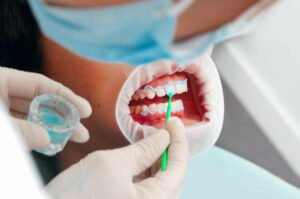Cosmetic Dentistry Grant Complaints 2024 – Addressing Complaints and Concerns

Explore the realm and common concerns of cosmetic dentistry grant complaints. Discover how these grants alleviate financial burdens while ensuring quality dental care.
Cosmetic dentistry grants complaints explains an interest in understanding and addressing issues or grievances related to cosmetic dentistry grant programs. It indicates a desire to explore potential complaints or concerns that individuals may have regarding the availability, accessibility, or effectiveness of such grants. This could be used for research purposes, such as identifying common complaints among grant applicants or recipients, assessing the satisfaction levels with existing grant programs, or seeking solutions to improve the grant allocation process and address any areas of dissatisfaction. It reflects an interest in examining the intersection of cosmetic dentistry, financial assistance, and consumer feedback.

Common Complaints Surrounding Cosmetic Dentistry Grants
1. Lack of Transparency in Grant Allocation:
Many individuals may express frustration over a perceived lack of transparency in how cosmetic dentistry grants are allocated. They might feel uncertain about the criteria used to determine grant recipients or how funds are distributed among applicants. Without clear guidelines or explanations, applicants may feel disheartened or distrustful of the process.
2. Limited Coverage:
Complaints may arise regarding the limited coverage provided by cosmetic dentistry grants. Some individuals may find that grants only cover specific procedures or contribute partially to the overall cost of treatment. This limitation could result in financial strain for applicants who require comprehensive dental work but find that grant funds do not fully address their needs.
3. Eligibility Issues:
Applicants may encounter frustrations with eligibility requirements for cosmetic dentistry grants. These requirements could be overly restrictive, excluding individuals who could benefit from financial assistance. Factors such as income thresholds, residency status, or specific dental conditions may prevent otherwise deserving candidates from accessing grant funds.
4. Lengthy Application Processes:
Complaints may stem from the complexity or time-consuming nature of the application process for cosmetic dentistry grants. Lengthy paperwork, documentation requirements, or multiple stages of review can create barriers for applicants, particularly those facing urgent dental issues. Delays in processing applications can further exacerbate these frustrations.
5. Funding Delays:
Individuals may experience delays in receiving grant funds or approvals, leading to financial uncertainty and anxiety. Whether due to bureaucratic processes, limited funding availability, or administrative backlog, delays in accessing grant support can prolong the wait for much-needed dental care and treatment.
6. Quality of Care:
Concerns about the quality of dental services provided through grant programs may arise if individuals perceive a discrepancy in the standard of care compared to private dental practices. Questions regarding the qualifications and expertise of participating dentists, the use of appropriate materials and techniques, or the overall effectiveness of treatments may contribute to dissatisfaction among grant recipients.
7. Communication Challenges:
Applicants may encounter difficulties in obtaining clear and timely communication from grant administrators regarding their application status, requirements, or available resources. Poor communication channels or lack of responsiveness can leave individuals feeling frustrated and uninformed throughout the grant application and treatment process.
8. Accessibility Barriers:
Complaints may arise regarding the lack of accessibility to cosmetic dentistry grant programs in certain geographic areas or communities. Limited availability of grant funding or participating dental providers in rural or underserved regions can create disparities in access to affordable dental care, leaving some individuals without viable options for assistance.
9. Insufficient Information:
Frustrations may emerge from a perceived lack of comprehensive information about available cosmetic dentistry grants, including eligibility criteria, application deadlines, and available resources. Incomplete or unclear guidance can make it challenging for individuals to navigate the grant application process effectively, leading to missed opportunities for financial assistance.
10. Lack of Follow-up Support:
Individuals may express concerns about the absence of adequate post-procedure support or follow-up care following treatment funded by cosmetic dentistry grants. Lack of guidance on post-treatment care, complications management, or access to additional services can leave patients feeling unsupported and isolated after undergoing dental procedures through grant programs.

READ ALSO:
Grants for Breast Cancer Patients 2024 | Find Financial Assistance Today.
Eligibility Requirements for Cosmetic Dentistry Grants
Eligibility requirements for cosmetic dentistry grants can vary depending on the specific grant program and the organization offering it. However, common eligibility criteria may include:
1. Financial Need: Many cosmetic dentistry grants target individuals with financial limitations who are unable to afford necessary dental procedures on their own. Applicants may be required to demonstrate their financial need through income verification documents, tax returns, or proof of eligibility for government assistance programs.
2. Dental Health Status: Some grant programs prioritize individuals with specific dental health conditions or issues that significantly impact their oral health and quality of life. Applicants may need to provide documentation from a dentist or healthcare provider detailing their dental health status and the recommended treatments.
3. Residency Status: Grant programs may restrict eligibility to residents of specific geographic areas, such as a particular city, state, or country. Applicants may need to provide proof of residency, such as a driver’s license, utility bill, or lease agreement.
4. Age Restrictions: Certain grant programs may have age restrictions, such as being limited to adults over a certain age or minors accompanied by a legal guardian. These restrictions are typically based on the target demographic or funding priorities of the organization offering the grants.
5. Insurance Coverage: Applicants may be required to demonstrate that they do not have adequate dental insurance coverage to afford the necessary procedures. This may involve providing proof of insurance denial or inability to obtain coverage for the specific treatment needed.
6. Documentation Requirements: Grant applications often require various forms of documentation to support the applicant’s eligibility, including medical records, treatment plans, dentist recommendations, and personal statements outlining their circumstances and need for assistance.
7. Compliance with Program Guidelines: Applicants must adhere to the specific guidelines and requirements outlined by the grant program, including deadlines for submission, completion of all application materials, and agreement to any terms and conditions associated with receiving the grant funds.
It’s essential for individuals considering applying for cosmetic dentistry grants to carefully review the eligibility criteria and application requirements of each program to determine their eligibility and maximize their chances of receiving assistance. Additionally, seeking guidance from dental professionals or nonprofit organizations specializing in dental assistance can help navigate the application process effectively.
Addressing Concerns about Grant Allocation
Addressing concerns about grant allocation is crucial to ensure fairness, transparency, and effectiveness in distributing funds to those in need. Here are several strategies to address these concerns:
1. Transparent Guidelines: Establish clear and transparent guidelines outlining the criteria for awarding grants. This includes criteria such as financial need, dental health status, residency, and other relevant factors. Make these guidelines readily available to applicants and stakeholders to foster transparency and trust in the allocation process.
2. Equitable Distribution: Ensure that grant funds are distributed equitably among eligible applicants based on their demonstrated need and the severity of their dental health issues. Implementing a fair evaluation process that considers all relevant factors can help prevent bias and ensure that funds are allocated where they are most needed.
3. Independent Review: Consider establishing an independent review panel or committee comprised of dental professionals, community representatives, and other stakeholders to evaluate grant applications. This can help ensure objectivity and fairness in the decision-making process and provide additional oversight to prevent potential conflicts of interest.
4. Regular Monitoring and Evaluation: Implement a system for monitoring and evaluating the effectiveness of the grant allocation process regularly. This includes tracking key metrics such as the number of applications received, the distribution of funds, and the outcomes of funded treatments. Use this data to identify any disparities or areas for improvement and make adjustments as needed.
5. Feedback Mechanisms: Establish mechanisms for collecting feedback from grant applicants, recipients, and other stakeholders about their experiences with the allocation process. This feedback can provide valuable insights into areas of concern or dissatisfaction and help inform improvements to the process over time.
6. Transparency in Decision-Making: Maintain transparency in the decision-making process by providing clear explanations for funding decisions to applicants. If an application is denied, provide specific reasons for the decision and offer guidance on alternative resources or options available to the applicant.
7. Continuous Improvement: Commit to continuous improvement in the grant allocation process based on feedback, evaluation data, and best practices in grant management. Regularly review and update allocation procedures, guidelines, and eligibility criteria to ensure that they remain responsive to the needs of the community and aligned with the goals of the grant program.
By implementing these strategies, organizations can address concerns about grant allocation and build confidence among applicants and stakeholders in the fairness and effectiveness of the process.
Tips for dealing with cosmetic dentistry grant issues
Dealing with cosmetic dentistry grant issues can be challenging, but there are several tips to help navigate these situations effectively:
1. Understand the Grant Guidelines: Familiarize yourself with the specific guidelines and requirements of the cosmetic dentistry grant program you are applying to or have received assistance from. Understanding the eligibility criteria, application process, and any terms and conditions associated with the grant can help you navigate potential issues more effectively.
2. Keep Detailed Records: Maintain detailed records of all communications, documentation, and interactions related to your grant application or treatment. This includes copies of application materials, correspondence with grant administrators, treatment plans, invoices, receipts, and any other relevant documentation. Having thorough records can help you track the progress of your application or treatment and provide evidence to support your case if issues arise.
3. Communicate Clearly and Respectfully: If you encounter any issues or concerns with the grant program or the services provided, communicate your concerns clearly and respectfully to the appropriate parties. Whether it’s addressing delays in funding, discrepancies in treatment, or misunderstandings about eligibility, open and respectful communication can help facilitate resolution and prevent misunderstandings.
4. Seek Guidance and Support: If you’re unsure how to address a particular issue or navigate the grant process, seek guidance and support from relevant resources. This could include contacting the grant program administrators directly, consulting with dental professionals or advocacy organizations specializing in dental grants, or seeking assistance from legal or consumer rights experts if necessary.
5. Follow Up Regularly: Stay proactive in following up on the status of your grant application or treatment, particularly if you encounter delays or issues along the way. Regularly check in with grant administrators or dental providers to inquire about the progress of your application or treatment and to address any concerns or questions that arise.
6. Be Patient and Persistent: Dealing with grant issues may require patience and persistence, especially if there are bureaucratic hurdles or delays to overcome. Stay committed to advocating for yourself and pursuing resolution to any issues or concerns you encounter, even if it takes time and effort to reach a satisfactory outcome.
7. Explore Alternative Options: If you’re facing significant challenges or roadblocks with a cosmetic dentistry grant program, consider exploring alternative options for funding or treatment. This could include seeking assistance from other grant programs, exploring financing options, or discussing alternative treatment plans with your dental provider.
By following these tips and staying proactive in addressing any issues or concerns that arise, you can navigate cosmetic dentistry grant issues more effectively and maximize your chances of accessing the assistance you need for dental care and treatment.

Conclusion on Cosmetic Dentistry Grant Complaints
Dealing with cosmetic dentistry grant issues requires patience, persistence, and proactive communication. By understanding the grant guidelines, keeping detailed records, and seeking guidance and support when needed, individuals can navigate potential challenges more effectively. Clear and respectful communication, regular follow-up, and a willingness to explore alternative options are essential in addressing issues and advocating for resolution.
Despite potential obstacles, staying committed to the process and maintaining a positive attitude can ultimately lead to a successful outcome. Whether it’s addressing delays, eligibility concerns, or treatment discrepancies, individuals can empower themselves by taking proactive steps to navigate cosmetic dentistry grant issues and access the dental care they need.
Frequently asked questions on Cosmetic Dentistry Grant Complaints.
What is a cosmetic dentistry grant?
A: A cosmetic dentistry grant is financial assistance provided to individuals who require cosmetic dental procedures but may not have the means to afford them. These grants help cover some or all of the costs associated with cosmetic dental treatments such as veneers, teeth whitening, or orthodontic work.
How can I qualify for a cosmetic dentistry grant?
Eligibility criteria for cosmetic dentistry grants vary depending on the grant program. Generally, applicants must demonstrate financial need, have specific dental health issues that require treatment, and meet other program-specific requirements. It’s important to review the guidelines of each grant program carefully to determine eligibility.
Are cosmetic dentistry grants available for everyone?
Cosmetic dentistry grants are typically targeted towards individuals with financial limitations who cannot afford necessary dental procedures on their own. While eligibility requirements may vary, not all individuals may qualify for these grants. However, there are often alternative funding options available, such as dental financing plans or other assistance programs.
What types of cosmetic dental procedures are covered by grants?
The types of cosmetic dental procedures covered by grants can vary depending on the specific grant program. Common procedures may include teeth whitening, dental veneers, dental implants, orthodontic treatments, and more. It’s important to check the coverage details of each grant program to determine which procedures are eligible for funding.
How can I apply for a cosmetic dentistry grant?
To apply for a cosmetic dentistry grant, you typically need to fill out an application form provided by the grant program and submit supporting documentation, such as proof of income, dental health records, and treatment plans. Application procedures may vary depending on the program, so be sure to follow the instructions provided by the grant administrator.
What should I do if I encounter issues with a cosmetic dentistry grant?
If you encounter issues with a cosmetic dentistry grant, such as delays in funding, eligibility concerns, or discrepancies in treatment, it’s important to communicate your concerns clearly and respectfully to the grant program administrators. Keep detailed records of all communications and documentation related to your grant application or treatment, and seek guidance and support from relevant resources if needed.



